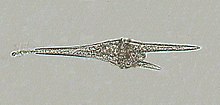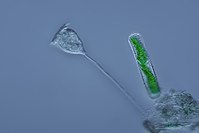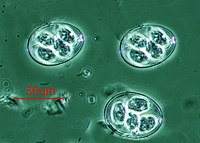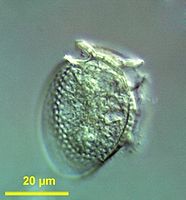Alveolate
| Alveolate Temporal range:
| |
|---|---|

| |
| Ceratium furca | |
| Scientific classification | |
| Domain: | Eukaryota |
| Clade: | Diaphoretickes |
| Clade: | TSAR |
| Clade: | SAR |
| Clade: | Alveolata Cavalier-Smith,1991 |
| Phyla | |
| Synonyms | |
| |
Thealveolates(meaning "pitted like a honeycomb" )[2]are a group ofprotists,considered a majorclade[3]andsuperphylum[4]withinEukarya.They are currently grouped with thestramenopilesandRhizariaamong the protists with tubulocristate mitochondria into theSAR supergroup.
Characteristics[edit]
The most notable shared characteristic is the presence ofcortical (near the surface) alveoli (sacs).These are flattenedvesicles(sacs) arranged as a layer just under themembraneand supporting it, typically contributing to a flexible pellicle (thin skin). In armoreddinoflagellatesthey may contain stiff plates. Alveolates havemitochondriawith tubular cristae (invaginations), and cells often have pore-like intrusions through the cell surface. The group contains free-living andparasiticorganisms, predatoryflagellates,andphotosyntheticorganisms.

Almost all sequenced mitochondrial genomes of ciliates and apicomplexa are linear.[5]The mitochondria almost all carrymtDNAof their own but with greatly reduced genome sizes. Exceptions areCryptosporidiumwhich are left with only amitosome,the circular mitochondrial genomes ofAcavomonasandBabesia microti,[6][7]andToxoplasma's highly fragmented mitochondrial genome, consisting of 21 sequence blocks which recombine to produce longer segments.[8][9]
History[edit]
The relationship of apicomplexa, dinoflagellates and ciliates had been suggested during the 1980s, and this was confirmed in the early 1990s by comparisons of ribosomal RNA sequences, most notably by Gajadharet al.[10]Cavalier-Smithintroduced the formal name Alveolata in 1991,[11]although at the time he considered the grouping to be aparaphyleticassemblage. Many biologists prefer the use of the colloquial name 'alveolate'.[12]
Classification[edit]
Alveolata include around nine major and minor groups. They are diverse in form, and are known to be related by various ultrastructural and genetic similarities:[13]
- Ciliates– very common protozoa with many shortciliaarranged in rows, and two nuclei
- Acavomonidia[13]
- Colponemidia[13]
- Dinoflagellatess.l. – mostly marineflagellatesmany of which havechloroplasts
- Perkinsozoa
- Chromerida– a marine phylum of photosynthetic protozoa
- Colpodellida
- Voromonadida
- Apicomplexa– parasitic and secondary non-photosynthetic protozoa that lackaxonemallocomotive structures except ingametes
The Acavomonidia and Colponemidia were previously grouped together as colponemids, a taxon now split because each has a distinctive organization orultrastructural identity.The Acavomonidia are closer to the dinoflagellate/perkinsid group than the Colponemidia are.[13]As such, the informal term "colponemids", as it stands currently, covers two non-sister groups within Alveolata: the Acavomonidia and the Colponemidia.[13]
The Apicomplexa and dinoflagellates may be more closely related to each other than to the ciliates. Both haveplastids,and most share a bundle or cone ofmicrotubulesat the top of the cell. In apicomplexans this forms part of a complex used to enter host cells, while in some colorless dinoflagellates it forms a peduncle used to ingest prey. Various other genera are closely related to these two groups, mostly flagellates with a similar apical structure. These include free-living members inOxyrrhisandColponema,and parasites inPerkinsus,[14]Parvilucifera,Rastrimonasand theellobiopsids.In 2001, direct amplification of therRNAgene in marinepicoplanktonsamples revealed the presence of two novel alveolate lineages, called group I and II.[15][16]Group I has no cultivated relatives, while group II is related to the dinoflagellate parasiteAmoebophrya,which was classified until now in theSyndinialesdinoflagellate order.
Some studies suggested thehaplosporids,mostly parasites of marine invertebrates, might belong here, but they lack alveoli and are now placed among theCercozoa.
The ellobiopsids are of uncertain relation within the alveolates. Silberman et al 2004 establish that theThalassomycesgenus of ellobiopsids are alveolates usingphylogeneticanalysis, however as of 2016[update]no more certainty exists on their place.[17][18]
Phylogeny[edit]
In 2017,Thomas Cavalier-Smithdescribed the phylogeny of the Alveolata as follows:[19]
Taxonomy[edit]
AlveolataCavalier-Smith 1991[Alveolatobiontes]
- PhylumCiliophoraDoflein 1901 stat. n. Copeland 1956[CiliataPerty 1852;InfusoriaBütschli 1887;Ciliae, Ciliozoa, Cytoidea, Eozoa, Heterocaryota, Heterokaryota]
- SubphylumPostciliodesmatophoraGerassimova & Seravin 1976
- ClassHeterotricheaStein 1859
- ClassKaryorelicteaCorliss 1974
- SubphylumIntramacronucleataLynn 1996
- Class?MesodinieaChen et al. 2015
- Infraphylum Lamellicorticata
- ClassLitostomateaSmall & Lynn 1981
- ClassArmophoreaLynn 2004
- ClassCariacotricheaOrsi et al. 2011
- ClassSpirotricheaBütschli 1889
- Infraphylum VentrataCavalier-Smith 2004[ConthreepLynn 2012]
- Order?DiscotrichidaChen et al. 2015
- ClassProtocruzieaChen et al. 2015[Protocruziidiade Puytorac, Grain & Mignot 1987]
- ClassColpodeaSmall & Lynn 1981
- ClassNassophoreaSmall & Lynn 1981
- ClassPhyllopharyngeade Puytorac et al. 1974
- ClassProstomateaSchewiakoff 1896
- ClassPlagiopyleaSmall & Lynn 1985 sensu Lynn 2008
- ClassOligohymenophoreade Puytorac et al. 1974
- SubphylumPostciliodesmatophoraGerassimova & Seravin 1976
- PhylumMiozoaCavalier-Smith 1987
- Subphylum ColponemidiaTikhonenkov, Mylnikov & Keeling 2013
- ClassColponemeaCavalier-Smith 1993
- Subphylum AcavomonadiaTikhonenkov et al. 2014
- ClassAcavomonadeaTikhonenkov et al. 2014
- SubphylumMyzozoaCavalier-Smith 2004
- InfraphylumApicomplexaLevine 1970 emend. Adl et al. 2005
- Order?VitrellidaCavalier-Smith 2017
- Class?MyzomonadeaCavalier-Smith & Chao 2004 sensu Ruggiero et al. 2015
- ClassChromerea
- OrderColpodellidaPatterson & Zölffel 1991[SpiromonadidaKrylov & Mylnikov 1986]
- SuperclassSporozoaLeuckart 1879 stat. nov. Cavalier-Smith 2013[Gamontozoa]
- ClassBlastogregarinidaChatton & Villeneuve 1936[Blastogregarinina; BlastogregarinorinaChatton & Villeneuve 1936]
- ClassParagregareaCavalier-Smith 2014
- ClassGregarinomorpheaGrassé 1953
- ClassCoccidiomorpheaDoflein 1901
- InfraphylumDinozoaCavalier-Smith 1981 emend. 2003
- Order?AcrocoelidaCavalier-Smith & Chao 2004
- Order?RastromonadidaCavalier-Smith & Chao 2004
- ClassSquirmideaNorén 1999 stat. nov. Cavalier-Smith 2014
- SuperclassPerkinsozoaNorén et al. 1999 s.s.
- ClassPerkinseaLevine 1978[PerkinsasidaLevine 1978]
- SuperclassDinoflagellataButschli 1885 stat. nov. Cavalier-Smith 1999 sensu Cavalier-Smith 2013[DinozoaCavalier-Smith 1981]
- ClassPronoctilucea
- ClassEllobiopseaCavalier-Smith 1993[EllobiophyceaeLoeblich III 1970;EllobiopsidaWhisler 1990]
- ClassMyzodineaCavalier-Smith 2017
- ClassOxyrrheaCavalier-Smith 1987
- ClassSyndineaChatton 1920 s.l.[SyndiniophyceaeLoeblich III 1970 s.s.;SyndinaCavalier-Smith]
- ClassEndodineaCavalier-Smith 2017
- ClassNoctiluciphyceaeFensome et al. 1993[NoctilucaeHaeckel 1866;NoctiluceaHaeckel 1866 stat. nov.;CystoflagellataHaeckel 1873 stat. nov. Butschli 1887]
- ClassDinophyceaePascher 1914[PeridineaEhrenberg 1830 stat. nov. Wettstein]
- InfraphylumApicomplexaLevine 1970 emend. Adl et al. 2005
- Subphylum ColponemidiaTikhonenkov, Mylnikov & Keeling 2013
Development[edit]
The development of plastids among the alveolates is intriguing. Cavalier-Smith proposed the alveolates developed from a chloroplast-containing ancestor, which also gave rise to theChromista(thechromalveolatehypothesis). Other researchers have speculated that the alveolates originally lacked plastids and possibly the dinoflagellates and Apicomplexa acquired them separately. However, it now appears that the alveolates, the dinoflagellates, the Chromerida and theheterokont algaeacquired their plastids from a red alga with evidence of a common origin of this organelle in all these four clades.[20]
Evolution[edit]
A Bayesian estimate places the evolution of the alveolate group at ~850million years ago.[21]The Alveolata consist ofMyzozoa,Ciliates,and Colponemids. In other words, the term Myzozoa, meaning "to siphon the contents from prey", may be applied informally to the common ancestor of the subset of alveolates that are neither ciliates nor colponemids. Predation upon algae is an important driver in alveolate evolution, as it can provide sources for endosymbiosis of novel plastids. The term Myzozoa is therefore a handy concept for tracking the history of the alveolate phylum.
The ancestors of the alveolate group may have been photosynthetic.[22]The ancestral alveolate probably possessed aplastid.Chromerids, apicomplexans, and peridinin dinoflagellates have retained thisorganelle.[23]Going one step even further back, the chromerids, the peridinin dinoflagellates and theheterokont algaehave been argued to possess a monophyletic plastid lineage in common, i.e. acquired their plastids from ared alga,[20]and so it seems likely that the common ancestor of alveolates and heterokonts was also photosynthetic.
In one school of thought the common ancestor of thedinoflagellates,apicomplexans,Colpodella,Chromerida,andVoromonaswas a myzocytotic predator with two heterodynamicflagella,micropores,trichocysts,rhoptries,micronemes,a polar ring and a coiled open sidedconoid.[24]While the common ancestor of alveolates may also have possessed some of these characteristics, it has been argued that Myzocytosis was not one of these characteristics, as ciliates ingest prey by a different mechanism.[13]
An ongoing debate concerns the number of membranes surrounding the plastid across apicomplexans and certain dinoflagellates, and the origin of these membranes. This ultrastructural character can be used to group organisms and if the character is in common, it can imply that phyla had a common photosynthetic ancestor. On the basis that apicomplexans possess a plastid surrounded by four membranes, and that peridinin dinoflagellates possess a plastid surrounded by three membranes, Petersen et al.[25]have been unable to rule out that the shared stramenopile-alveolate plastid could have been recycled multiple times in the alveolate phylum, the source being stramenopile-alveolate donors, through the mechanism of ingestion andendosymbiosis.
Ciliates are a model alveolate, having been genetically studied in great depth over the longest period of any alveolate lineage. They are unusual among eukaryotes in that reproduction involves amicronucleusand amacronucleus.Their reproduction is easily studied in the lab, and made them a model eukaryote historically. Being entirely predatory and lacking any remnant plastid, their development as a phylum illustrates how predation and autotrophy[22]are in dynamic balance and that the balance can swing one way or other at the point of origin of a new phylum from mixotrophic ancestors, causing one ability to be lost.
-
Vorticella(Ciliophora) (left)
-
Plasmodium falciparum(Apicomplexa) in blood
Epigenetics[edit]
Fewalgaehave been studied forepigenetics.[26]Those for which epigenetic data are available include some algal alveolates.[26]
References[edit]
- ^ Li CW, et al. (2007). "Ciliated protozoans from the Precambrian Doushantuo Formation, Wengan, South China".Geological Society, London, Special Publications.286(1): 151–6.Bibcode:2007GSLSP.286..151L.doi:10.1144/SP286.11.S2CID129584945.
- ^"alveolate".Memidex (WordNet) Dictionary/Thesaurus.Archived fromthe originalon 2016-04-11.Retrieved2011-01-26.
- ^Adl S, et al. (2012)."The revised classification of eukaryotes".Journal of Eukaryotic Microbiology.59(5): 429–514.doi:10.1111/j.1550-7408.2012.00644.x.PMC3483872.PMID23020233.
- ^Ruggiero MA, Gordon DP, Orrell TM, Bailly N, Bourgoin T, Brusca RC, Cavalier-Smith T, Guiry MD, Kirk PM (2015)."A higher level classification of all living organisms".PLOS ONE.10(4): e0119248.Bibcode:2015PLoSO..1019248R.doi:10.1371/journal.pone.0119248.PMC4418965.PMID25923521.
- ^Barth D, Berendonk TU (2011)."The mitochondrial genome sequence of the ciliateParamecium caudatumreveals a shift in nucleotide composition and codon usage within the genusParamecium".BMC Genomics.12:272.doi:10.1186/1471-2164-12-272.PMC3118789.PMID21627782.
- ^Oborník M, Lukeš J (2015-10-15)."The Organellar Genomes of Chromera and Vitrella, the Phototrophic Relatives of Apicomplexan Parasites".Annual Review of Microbiology.69:129–144.doi:10.1146/annurev-micro-091014-104449.ISSN0066-4227.PMID26092225.Retrieved2024-04-15.
- ^Cornillot E, Hadj-Kaddour K, Dassouli A, Noel B, Ranwez V, Vacherie B, Augagneur Y, Brès V, Duclos A, Randazzo S, Carcy B, Debierre-Grockiego F, Delbecq S, Moubri-Ménage K, Shams-Eldin H, Usmani-Brown S, Bringaud F, Wincker P, Vivarès CP, Schwarz RT, Schetters TP, Krause PJ, Gorenflot A, Berry V, Barbe V, Ben Mamoun C (2012)."Sequencing of the smallest Apicomplexan genome from the human pathogenBabesia microti".Nucleic Acids Res.40(18): 9102–14.doi:10.1093/nar/gks700.PMC3467087.PMID22833609.
- ^Namasivayam S, Baptista RP, Xiao W, Hall EM, Doggett JS, Troell K, Kissinger JC (May 2021)."A novel fragmented mitochondrial genome in the protist pathogen Toxoplasma gondii and related tissue coccidia".Genome Research.31(5): 852–865.doi:10.1101/gr.266403.120.PMC8092004.PMID33906963.
- ^Namasivayam S, Sun C, Bah AB, Oberstaller J, Pierre-Louis E, Etheridge RD, Feschotte C, Pritham EJ, Kissinger JC (2023-11-07)."Massive invasion of organellar DNA drives nuclear genome evolution in Toxoplasma".Proceedings of the National Academy of Sciences.120(45): –2308569120.Bibcode:2023PNAS..12008569N.doi:10.1073/pnas.2308569120.PMC10636329.PMID37917792.
- ^ Gajadhar, A. A., et al. (1991). "Ribosomal RNA sequences ofSarcocystis muris,Theilera annulata,andCrypthecodinium cohniireveal evolutionary relationships among apicomplexans, dinoflagellates, and ciliates ".Molecular and Biochemical Parasitology.45(1): 147–153.doi:10.1016/0166-6851(91)90036-6.PMID1904987..
- ^Cavalier-Smith T (1991)."Cell diversification in heterotrophic flagellates".In Patterson DJ, Larsen J, Systematics Association (eds.).The Biology of free-living heterotrophic flagellates.Oxford University Press. pp. 113–131.ISBN978-0-19-857747-8.
- ^Kumar, S. & Rzhetsky, A. 1996. Evolutionary relationships of eukaryotic kingdoms. Journal of Molecular Evolution, 42: 183–193
- ^abcdefTikhonenkov DV, Janouškovec J, Mylnikov AP, Mikhailov KV, Simdyanov TG, Aleoshin VV, Keeling PJ (2014)."Description ofColponema vietnamicasp.n. andAcavomonas peruvianan. gen. n. sp., two new alveolate phyla (Colponemidia nom. nov. and Acavomonidia nom. nov.) and their contributions to reconstructing the ancestral state of alveolates and eukaryotes ".PLOS ONE.9(4): e95467.Bibcode:2014PLoSO...995467T.doi:10.1371/journal.pone.0095467.PMC3989336.PMID24740116.
- ^Zhang H, Campbell DA, Sturm NR, Dungan CF, Lin S (2011)."Spliced leader RNAs, mitochondrial gene frameshifts and multi-protein phylogeny expand support for the genusPerkinsusas a unique group of Alveolates ".PLOS ONE.6(5): e19933.Bibcode:2011PLoSO...619933Z.doi:10.1371/journal.pone.0019933.PMC3101222.PMID21629701.
- ^López-García P, Rodríguez-Valera F, Pedrós-Alió C, Moreira D (2001). "Unexpected diversity of small eukaryotes in deep-sea Antarctic plankton".Nature.409(6820): 603–7.Bibcode:2001Natur.409..603L.doi:10.1038/35054537.PMID11214316.S2CID11550698.
- ^Moon-van der Staay SY, De Wachter R, Vaulot D (2001). "Oceanic 18S rDNA sequences from picoplankton reveal unsuspected eukaryotic diversity".Nature.409(6820): 607–10.Bibcode:2001Natur.409..607M.doi:10.1038/35054541.PMID11214317.S2CID4362835.
- ^Hoppenrath M (2016-04-29). "Dinoflagellate taxonomy — a review and proposal of a revised classification".Marine Biodiversity.47(2).Senckenberg Institute(Springer): 381–403.doi:10.1007/s12526-016-0471-8(inactive 2024-05-03).ISSN1867-1616.S2CID42100119.
{{cite journal}}:CS1 maint: DOI inactive as of May 2024 (link) - ^Taylor FJ (2004). "Illumination or confusion? Dinoflagellate molecular phylogenetic data viewed from a primarily morphological standpoint".Phycological Research.52(4).Japanese Society of Phycology(Wiley): 308–324.doi:10.1111/j.1440-183.2004.00360.x.ISSN1322-0829.S2CID86797666.
- ^Cavalier-Smith T (5 September 2017)."Kingdom Chromista and its eight phyla: a new synthesis emphasising periplastid protein targeting, cytoskeletal and periplastid evolution, and ancient divergences".Protoplasma.255(1): 297–357.doi:10.1007/s00709-017-1147-3(inactive 2024-05-03).PMC5756292.PMID28875267.
{{cite journal}}:CS1 maint: DOI inactive as of May 2024 (link) - ^abJanouskovec J, Horák A, Oborník M, Lukes J, Keeling PJ (2010)."A common red algal origin of the apicomplexan, dinoflagellate, and heterokont plastids".Proc Natl Acad Sci USA.107(24): 10949–54.Bibcode:2010PNAS..10710949J.doi:10.1073/pnas.1003335107.PMC2890776.PMID20534454.
- ^Berney C, Pawlowski J (2006)."A molecular time-scale for eukaryote evolution recalibrated with the continuous microfossil record".Proc Biol Sci.273(1596): 1867–72.doi:10.1098/rspb.2006.3537.PMC1634798.PMID16822745.
- ^abReyes-Prieto A, Moustafa A, Bhattacharya D (2008)."Multiple genes of apparent algal origin suggest ciliates may once have been photosynthetic".Curr. Biol.18(13): 956–62.Bibcode:2008CBio...18..956R.doi:10.1016/j.cub.2008.05.042.PMC2577054.PMID18595706.
- ^Moore RB, Oborník M, Janouskovec J, Chrudimský T, Vancová M, Green DH, Wright SW, Davies NW, Bolch CJ, Heimann K, Slapeta J, Hoegh-Guldberg O, Logsdon JM, Carter DA (2008). "A photosynthetic alveolate closely related to apicomplexan parasites".Nature.451(7181): 959–963.Bibcode:2008Natur.451..959M.doi:10.1038/nature06635.PMID18288187.S2CID28005870.
- ^Kuvardina ON, Leander BS, Aleshin VV, Myl'nikov AP, Keeling PJ, Simdyanov TG (2002)."The phylogeny of colpodellids (Alveolata) using small subunit rRNA gene sequences suggests they are the free living sister group to apicomplexans".J Eukaryot Microbiol.49(6): 498–504.doi:10.1111/j.1550-7408.2002.tb00235.x.PMID12503687.S2CID4283969.
- ^Petersen J, Ludewig AK, Michael V, Bunk B, Jarek M, Baurain D, Brinkmann H (2014)."Chromera velia,endosymbioses and the rhodoplex hypothesis—plastid evolution in cryptophytes, alveolates, stramenopiles, and haptophytes (CASH lineages) ".Genome Biol Evol.6(3): 666–684.doi:10.1093/gbe/evu043.PMC3971594.PMID24572015.
- ^abPiferrer F, Wang HP, eds. (2023).Epigenetics in Aquaculture.Wiley. pp. 383–411.doi:10.1002/9781119821946.hdl:10261/191758.ISBN978-1-119-82191-5.





